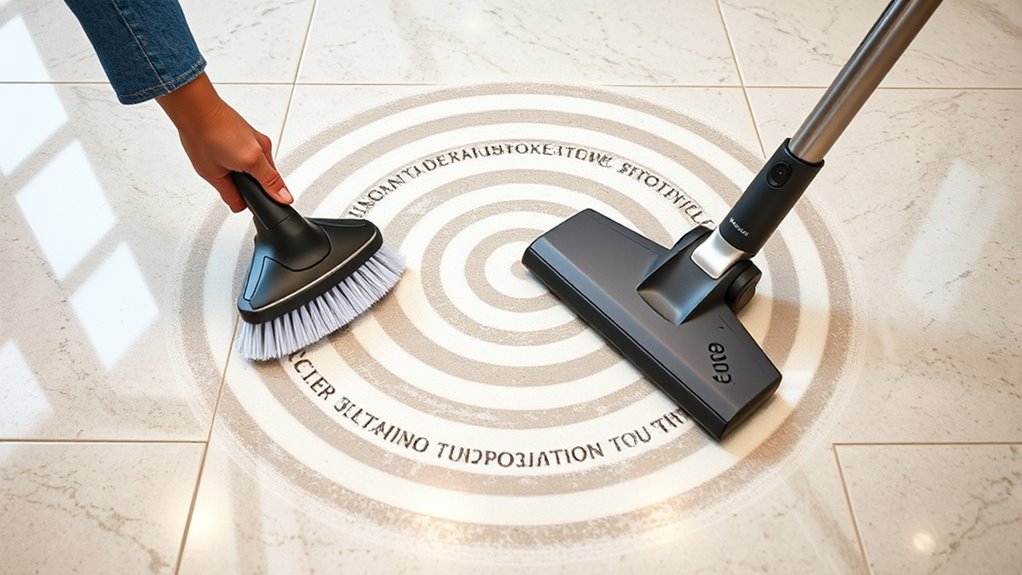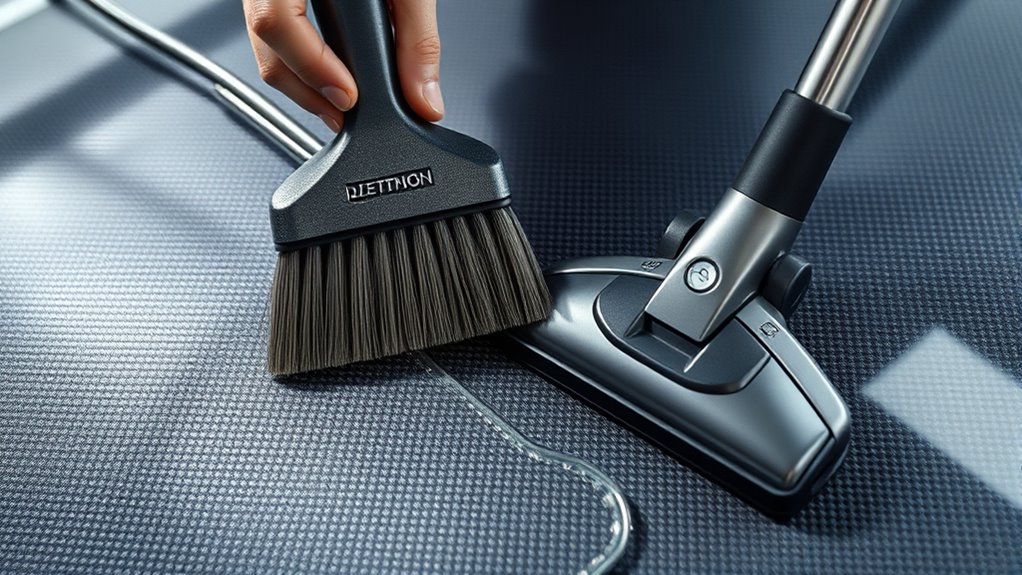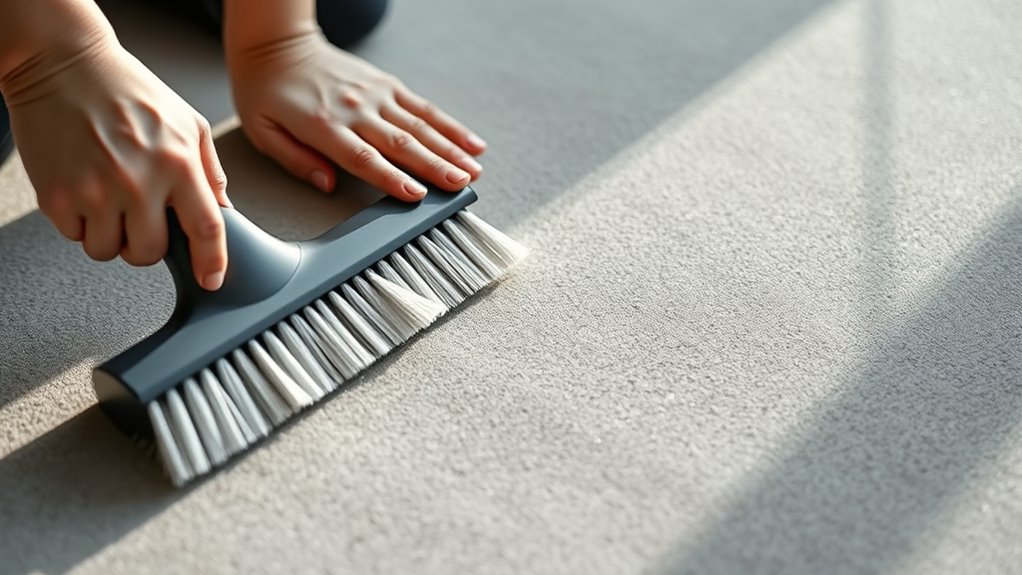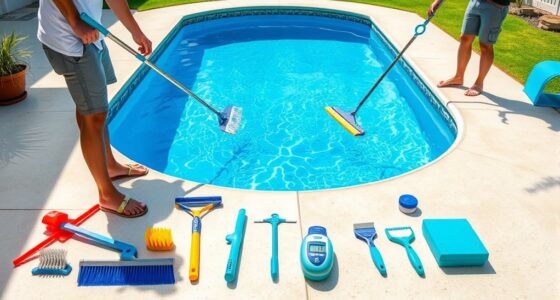To keep surfaces pristine, use a spiral technique to cover the area thoroughly and avoid missed spots. Incorporate overlapping passes by about a third to ensure consistent cleaning. Pay special attention to edges and corners with small, deliberate strokes. Apply a cross-hatch pattern to deep clean stubborn dirt, switching directions for maximum coverage. For best results, combine brushing to loosen debris with vacuuming to remove it effectively. Exploring these patterns further will elevate your cleaning game.
Key Takeaways
- Pros often use the spiral technique to ensure thorough coverage and prevent missed spots during brushing and vacuuming.
- Overlapping passes by about a third to half maximize debris pickup and avoid streaks or uneven cleaning.
- Combining a cross-hatch pattern enhances deep cleaning, especially on carpets and textured surfaces.
- Edge and corner detailing with small, deliberate strokes reach hard-to-access areas effectively.
- Sequencing brushing to loosen debris followed by vacuuming removes dirt efficiently and maintains surface integrity.
The Spiral Technique for Thorough Coverage

To guarantee you clean every corner effectively, try the spiral technique. Begin at one point in the room, and move in a tight circle, gradually expanding outward until you’ve covered the entire area. This pattern ensures you don’t miss spots or overlap unnecessarily. Keep your vacuum or brush close to the surface, maintaining steady pressure for consistent cleaning. As you work outward, pay attention to edges and corners, where dirt tends to collect. The spiral movement keeps your cleaning method organized and efficient, reducing the chances of leaving dirt behind. This technique works well on carpets, rugs, and even hard floors, providing a thorough clean. Incorporating tuning concepts can also enhance your vehicle’s overall performance, making maintenance more effective. With practice, you’ll find the spiral pattern helps you cover every inch thoroughly and quickly.
Overlapping Passes to Ensure No Spot Is Missed

After completing the spiral pattern, it’s important to make overlapping passes over the same area. This technique assures you don’t miss any spots or leave streaks behind. As you move, slightly shift your brush or vacuum head so each pass overlaps the previous one by about a third to half. Overlapping guarantees consistent coverage and helps pick up any debris the initial pass might have missed. It also prevents streaks or uneven cleaning, especially on larger surfaces. Maintain a steady, controlled pace so your overlapping passes are deliberate, not hasty. This method is particularly useful on textured surfaces or heavily soiled areas. Additionally, vacuum cleaner attachments can improve efficiency by allowing more precise cleaning in hard-to-reach spots. By overlapping your passes, you maximize cleaning efficiency and achieve a more uniform, pristine finish every time.
The Edge and Corner Method for Complete Detailing

When it comes to achieving a thorough clean, paying special attention to edges and corners is essential because these areas often trap more debris and are harder to reach with standard passes. To master this, focus your vacuum or brush along the boundary lines, angling the tool for maximum contact. Use small, deliberate strokes in tight spaces to lift dirt effectively. Incorporate the following approach for precision:
| Technique | Focus Area |
|---|---|
| Edge Sweeping | Baseboards, trim |
| Corner Circular Motions | Inside corners |
| Crevice Detailing | Tight gaps |
This method guarantees no debris is missed and surfaces are thoroughly cleaned, leaving your space pristine and well-maintained. Engaging in regular maintenance using these techniques helps prevent buildup and keeps surfaces looking their best.
The Cross-Hatch Pattern for Deep Cleaning

The cross-hatch pattern is a highly effective technique for deep cleaning surfaces because it guarantees thorough coverage and removal of embedded dirt. You start by brushing or vacuuming in one direction, then rotate 90 degrees to repeat the process. This crisscross approach ensures you reach every nook and cranny, loosening debris stuck deep within fibers or textures. Applying consistent pressure, you work systematically across the entire surface, avoiding missed spots. The pattern is especially useful on carpets, upholstery, and textured floors, where dirt can hide beneath the surface. By overlapping passes, you maximize dirt removal and improve surface appearance. This method not only deep cleans but also prepares surfaces for further treatment or finishing. Consistency and attention to detail are key for ideal results. Incorporating professional techniques can further enhance cleaning effectiveness and efficiency.
Combining Brushing and Vacuuming for Optimal Results

Combining brushing and vacuuming in your cleaning routine enhances overall effectiveness by addressing dirt at different levels. Brushing loosens debris from surfaces and fibers, making vacuuming more efficient. Vacuuming then removes loosened dirt and dust, leaving surfaces thoroughly clean. Think of it like this:
| Before Brushing | After Brushing | Post-Vacuuming |
|---|---|---|
| Embedded dirt | Loosened debris | Clean surface |
| Dust settling | Raised dust | Dust removed |
| Surface grime | Dislodged particles | Surface pristine |
This sequence ensures deep cleaning, reduces dirt buildup, and prolongs surface life. Combining these techniques creates a synergy that maximizes cleanliness, giving you pristine results every time. Regularly incorporating both methods can also help maintain surface integrity over time.
Frequently Asked Questions
What Tools Are Best Suited for These Cleaning Patterns?
You should use a high-quality vacuum cleaner with adjustable settings and a variety of attachments like a crevice tool and upholstery brush to follow cleaning patterns effectively. For brushing, choose a durable brush with soft or stiff bristles depending on the surface, and a handheld or electric scrub brush for precision. These tools help you clean efficiently, reach tight spots, and maintain surfaces in pristine condition.
How Often Should These Techniques Be Performed?
You should brush and vacuum regularly to maintain pristine surfaces. For most areas, aim to do this at least once a week to prevent dirt buildup and allergens. High-traffic zones may need cleaning two to three times weekly, while less-used spots can be cleaned biweekly or monthly. Consistency is key; sticking to a schedule keeps surfaces clean and extends their lifespan. Adjust frequency based on your environment and activity levels.
Are These Patterns Suitable for Delicate Surfaces?
Yes, these patterns are suitable for delicate surfaces if you adapt your approach. Use gentle, light strokes and avoid excessive pressure to prevent damage. For fragile materials like glass or fine wood, opt for softer brushes or vacuum attachments designed for delicate surfaces. Always test a small, hidden area first. By doing so, you guarantee cleanliness without risking harm, maintaining surface integrity while keeping them pristine.
Can These Methods Be Adapted for Outdoor Cleaning?
Yes, you can adapt these methods for outdoor cleaning. While they’re designed for delicate surfaces, you’ll want to choose sturdier brushes or vacuum attachments suited for rougher, outdoor debris. Adjust your patterns to cover larger areas efficiently, and use more powerful suction or brushing strength. This approach guarantees you keep outdoor surfaces clean without damaging them, making your cleaning routine effective and versatile for any environment.
What Are Common Mistakes to Avoid While Using These Patterns?
You should avoid rushing or skipping sections when cleaning, as inconsistent patterns can leave dirt behind. Don’t forget to modify directions frequently to prevent streaks or missed spots. Using the wrong tools or applying too much pressure can damage surfaces. Always follow the recommended techniques and stay systematic. By paying attention to your pattern, you’ll ensure a thorough clean and maintain the surfaces’ pristine condition.
Conclusion
By mastering these patterns, you’ll keep surfaces spotless with ease. Imagine you’re cleaning a dusty bookshelf; using the spiral technique, you cover every nook and cranny thoroughly. Or, when tackling stubborn pet hair, combining brushing and vacuuming ensures no spot gets overlooked. Consistently applying these methods transforms your cleaning routine, making surfaces gleam. With practice, you’ll see how efficient and satisfying maintaining pristine surfaces can be—just like a professional, every time.









